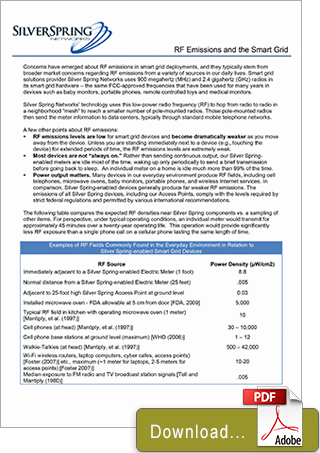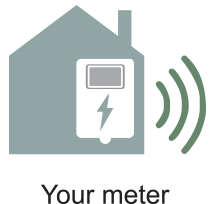 Concerns about RF emissions in smart grid deployments
Concerns about RF emissions in smart grid deployments
Concerns have emerged about RF emissions in smart grid deployments, and they typically stem from broader market concerns regarding RF emissions from a variety of sources in our daily lives. Smart grid solutions provider Silver Spring Networks uses 900 megahertz (MHz) and 2.4 gigahertz (GHz) radios in its smart grid hardware – the same FCC-approved frequencies that have been used for many years in devices such as baby monitors, portable phones, remote controlled toys and medical monitors.
Silver Spring Networks’ technology uses this low-power radio frequency (RF) to hop from radio to radio in a neighborhood “mesh” to reach a smaller number of pole-mounted radios. Those pole-mounted radios then send the meter information to data centers, typically through standard mobile telephone networks.
A few other points about RF emissions:
- RF emissions levels are low for smart grid devices and become dramatically weaker as you move away from the device. Unless you are standing immediately next to a device (e.g., touching the device) for extended periods of time, the RF emissions levels are extremely weak.
- Most devices are not “always on.” Rather than sending continuous output, our Silver Springenabled meters are idle most of the time, waking up only periodically to send a brief transmission before going back to sleep. An individual meter on a home is idle much more than 99% of the time.
- Power output matters. Many devices in our everyday environment produce RF fields, including cell telephones, microwave ovens, baby monitors, portable phones, and wireless Internet services. In comparison, Silver Spring-enabled devices generally produce far weaker RF emissions. The emissions of all Silver Spring devices, including our Access Points, comply with the levels required by strict federal regulations and permitted by various international recommendations.
The following table compares the expected RF densities near Silver Spring components vs. a sampling of other items. For perspective, under typical operating conditions, an individual meter would transmit for approximately 45 minutes over a twenty-year operating life. This operation would provide significantly less RF exposure than a single phone call on a cellular phone lasting the same length of time.
- SilverSpring Networks report 3/15/2010



 Mk10D
Mk10D